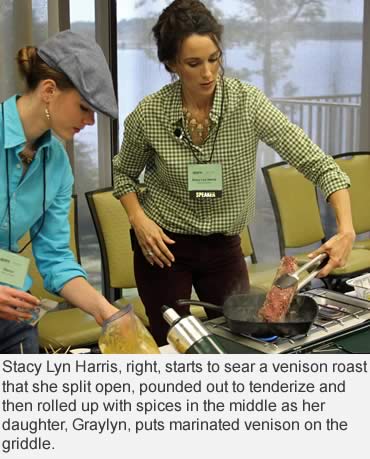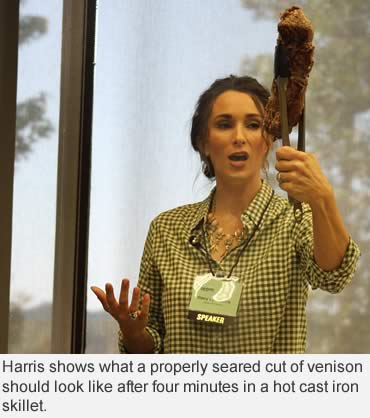With the Alabama gun deer season more than a week old, it’s probably safe to say fresh venison will soon be on the menu at hunting camps and homes around the state.
Any experienced hunter knows that care of the game after it is killed is the key to delectable dishes on the table.
Of course, there are many other tips and procedures that will make your diners come back for seconds.
And it would be difficult to find anyone more qualified with that kind of advice than Stacy Lyn Harris of Pike Road, Ala., who takes sustainable living to the limit in this land of bountiful wild game and favorable climate for year-round gardening.
Harris was one of the featured presenters recently at the Southeastern Outdoor Press Association (SEOPA) annual conference, held this year at beautiful Lakepoint Resort State Park on Lake Eufaula. She shared a number of venison preparation techniques with the outdoors communicators and industry representatives in attendance.
With our warm weather of late, Harris’ first rule is of utmost importance.
“As everybody knows, get your deer on ice right away,” Harris said. “Some of the people that follow my blog are from upstate New York, where they can hang their deer outside. I love the pictures of their deer hanging outside and aging. Here in the South, it’s very rare we can do that. So get it on ice as quickly as possible.
“Sometimes you’ll get a gamey flavor if you don’t get it on ice and get it processed right. If you process it right, you’re going to get great flavor from your venison.”
Harris’ blog at gameandgarden.com has been named one of the top 100 blogs with a variety of recipes, tips on sustainable living and the celebration of living in the South.
 “On my website you’ll find a link to ‘Ten Tips To Know When Preparing Venison,’” she said. “I got the idea (of aging venison) from Alton Brown (celebrity chef). I take a plastic bin and poke holes in the side, top and bottom. We put another bin without holes underneath it to catch the blood. We put our processed venison on racks and keep the air (34 to 37 degrees) circulating around the meat. We go about seven days on our venison. Some go longer, but we feel like seven days is enough.
“On my website you’ll find a link to ‘Ten Tips To Know When Preparing Venison,’” she said. “I got the idea (of aging venison) from Alton Brown (celebrity chef). I take a plastic bin and poke holes in the side, top and bottom. We put another bin without holes underneath it to catch the blood. We put our processed venison on racks and keep the air (34 to 37 degrees) circulating around the meat. We go about seven days on our venison. Some go longer, but we feel like seven days is enough.
“That aging breaks down the tissue and makes it so tender and succulent. If you skip that process, it’s not going to work.”
Harris said the exception to the above method is if you have a quality vacuum sealer that ensures no air will touch the venison. The meat can be unfrozen and then aged for seven days if it has an airtight seal.
“If you do it that way, you need to dry it,” she said. “If you’re in a hurry, you can put the meat in front of a fan and let it dry out. That helps the texture and flavor of your meat to dry it out.”
Many hunters prefer to process venison in two steps: cut out the backstraps and tenderloins whole and process the rest into ground meat.
Harris thinks that can be a mistake.
“Those tough cuts are some of the most flavorful you will find,” she said. “The collagen melts and makes incredible gravy. It is so delicious. The biggest thing to me is don’t mask the flavor; enhance it. Really, you can do everything with salt and pepper. You can sear your loin in a really hot skillet for about four minutes a side.
Then you can make your gravy with the drippings left over in the skillet with a little flour and a little wine or meat stock. You get that good and thick and you’re done. It is so fast and easy. People think cooking venison is hard, but it’s not.”
Harris said the key is not to overcook your venison unless you’re braising it in the low-and-slow method.
 “A lot of people don’t braise their meat at a low enough temperature,” she said. “They’ll put it in a soup and cook it at too high a temperature. The best braising temperature to me is between 131 and 149 degrees. I know that sounds low, but believe me it works. If your stove doesn’t go below 200, just do it at that temperature.
“A lot of people don’t braise their meat at a low enough temperature,” she said. “They’ll put it in a soup and cook it at too high a temperature. The best braising temperature to me is between 131 and 149 degrees. I know that sounds low, but believe me it works. If your stove doesn’t go below 200, just do it at that temperature.
“I like to brown my meat on all sides before I braise it. Then I’ll put it in the pan with my braising liquid, usually some kind of stock. Some people use deer stock, but I don’t. I use chicken stock or beef stock. It still makes a wonderful braise, along with some wine, mushrooms, aromatics like thyme and basil. Put it in the oven or on top of the stove at a low simmer for a very, very long time, like four hours. If you do that, you’ll get a fantastic meal.”
Harris, who gave up a law practice to pursue the sustainable living lifestyle, said that she really has to watch what she eats these days.
“I’ve had seven kids, and I have to watch my weight,” she said. “If I’m not going to have something that I really like, then I just won’t eat it. I’ll just pass if it’s not really great.”
Harris said it’s very important to match the cut of meat to the cooking method.
“If it’s a loin, it’s going to be fast and hot,” she said. “You want it medium rare to rare. I like mine medium rare. My husband (Scott) can almost eat it right off the carcass. A lot of people like it rare.
“There is one roast off the hindquarter that is like a ball. But it’s tough. I like to cut it in thin strips and then pound it out to break that connective tissue. Then I bread it and pan-fry it. Another way to cook it is the low-and-slow braise.”
Harris has authored three best-selling cookbooks: “Recipes and Tips for Sustainable Living,” “Tracking the Outdoor In” and “Wildgame: Food for Your Family.” Harris also has a DVD titled “Gourmet Venison.” All are available on Amazon.
Harris, who has been featured in a number of publications from glamour.com to Deer and Deer Hunting Magazine, said she will marinate venison at times and also will make a dry rub. She sometimes uses coffee in the dry rub to enhance the earthiness of the venison. She said Kosher salt helps break down the protein.
Best Dry Rub
(3 pounds of meat)
Ingredients
2 Tablespoons Kosher Salt
1 Tablespoon Ground Smoked Cumin
1 Tablespoon Freshly Ground Pepper
1 Tablespoon Ground Coriander
1 1/2 Teaspoons Garlic Powder
1 Teaspoon Cayenne Pepper
Mix all ingredients and rub thoroughly into the meat. Cover the meat and refrigerate for at least three hours. If possible, leave the meat in the refrigerator for 24 hours or overnight.
— Photos Courtesy David Rainer
— By David Rainer / Alabama Department of Conservation and Natural Resources